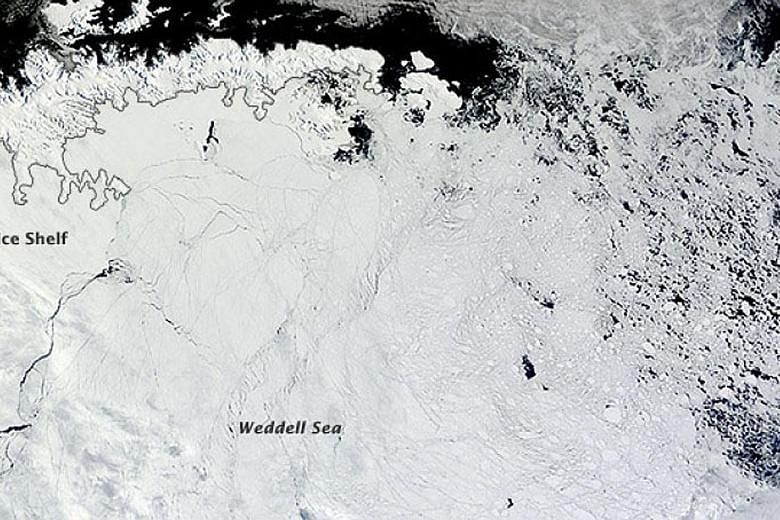WASHINGTON • For some time, scientists who focus on Antarctica have been watching the progression of a large crack in one of the world's biggest ice shelves - Larsen C.
This is the most northern major ice shelf of the Antarctic peninsula, and the fourth-largest Antarctic ice shelf overall.
Larsen C, according to the British Antarctic Survey, is "slightly smaller than Scotland". It is called an ice "shelf" because the entirety of this country-sized area is covered by 350m-thick ice that is floating on top of deep ocean waters.
The crack in Larsen C grew around 30km in length between 2011 and last year. As it grew, it became wider, yawning some 200m by last year.
Now, researchers monitoring Larsen C say that with the intense winter polar night over Antarctica ending, they have been able to see what happened to the crack during the time when it could not be observed by satellite.
-
COLD FACTS
22km
How much the rift in Larsen C has grown since it was last observed in March this year.
350m
Width of rift now.
130km
Full length of the rift now.
6,000 sq km
Amount of ice that could be lost.
The result was astonishing.
The rift has grown another 22km since it was last observed in March this year and has widened to about 350m, says a report by researchers from Project Midas, a British Antarctic Survey-funded collaboration of researchers. The full length of the rift is now 130km.
This means it may be only a matter of time before we see the loss of an enormous chunk of Larsen C - similar to the losses of the Larsen A ice shelf in 1995 and the sudden break-up of Larsen B in 2002.
The National Snow and Ice Data Centre said the 2002 event lost an earth feature that had "likely existed since the end of the last major glaciation 12,000 years ago".
According to Mr Adrian Luckman, Ms Daniela Jansen, Mr Martin O'Leary and members of the Project Midas team, "we previously showed that this will remove between 9 and 12 per cent of the ice shelf area and leave the ice front at its most retreated position ever".
The amount of ice that could be lost would be around 6,000 sq km, said Mr O'Leary, a glaciologist at Swansea University.
The possible ice island in the Southern Ocean, also known as the Antarctic Ocean, could be as large as one of the smallest US states.
Moreover, researchers studying the widening crack in a 2015 paper predict that after the loss of this ice, the remaining shelf could be unstable and lose more mass.
Ms Jansen, a researcher with the Alfred Wegener Institute Helmholtz Centre for Polar and Marine Research in Germany, said: "Once the iceberg has calved (when chunks of ice break off and fall into the water) off completely, there might be a tendency for the ice front to crumble backwards."
That could be further enhanced, she said, if warmer air temperatures cause the formation of numbers of meltwater lakes atop the shelf.
When ice shelves lose large chunks, this does not raise the sea level because these bodies are already afloat.
However, this can speed up the seaward flow of the non-floating glacial ice behind it, and this ice can in turn contribute to sea-level rise.
Researchers estimate that the loss of all the ice that the Larsen C ice shelf currently holds back would raise global sea levels by 10cm.
Earlier this year, a study in Nature Climate Change looked at ice shelves around Antarctica to determine how much area they could lose without ceasing to carry out their crucial function of buttressing glaciers.
The study found that Larsen C actually has a lot of "passive" ice that it can lose without major consequences.
WASHINGTON POST

